
First, a note on cultural appropriation
Annalee Newitz describes the appropriation of anime as "transforming Japanese
culture for [one's] own uses, which are somewhat different from the uses to which
it might be put in Japan." Yep, that would be exactly what I'm doing. In fact,
Newitz goes on to say how all non-Japanese anime fans appropriate anime as an alternative entertainment, subculture, whatever.
I am also appropriating Ranma 1/2 for my own queer purposes, something I don't think Rumiko Takahashi intended it for.
Appropriation can be a very bad thing if you don't know or admit that you're appropriating. It tends to disempower or silence the culture or people
being appropriated.
I'm saying right up front that I know I'm appropriating Ranma 1/2, in a couple of different ways, for this analysis. I try to take that into account
in my writing. I love Rumiko Takahashi's work, I try to be as respectful as possible of it and other possible readings of the material. Finally, I promise to give Ranma back
when I'm done!
Okay, on with the show. . .
How is Ranma 1/2 queer?
If you're not familiar with queer theory, it might be a good idea to read the section on queer theory before continuing.
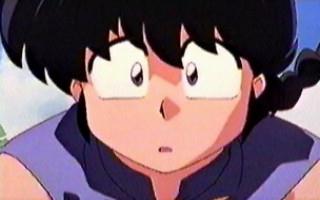 If he were a real person, Ranma Saotome would probably be horrified at being considered queer.
No matter that he identifies as male and has a female body some of the time, Ranma tries very hard
to be as straight as possible.
If he were a real person, Ranma Saotome would probably be horrified at being considered queer.
No matter that he identifies as male and has a female body some of the time, Ranma tries very hard
to be as straight as possible.
Ranma, buddy, you can relax.
I'm not saying Ranma is a queer person, because one kind of
has to identify oneself as queer. I can't do it for him, much as it would please me.
But just because Ranma thinks of himself as a straight guy with a curse (and the series thinks
of him the same way), doesn't mean that I can't point out queer moments, possibilities and
identifications all over the place. A big part of my queer reading (and queering) of
Ranma 1/2 lies in the possibilities the series presents, in what happens but isn't discussed, and
in the things it takes for granted. I will also point out ways in which Ranma 1/2 is completely
un-queer, falling into normative and heteronormative enforcement of gender and sexual roles.
Mrs. Akane Saotome? Not if she has anything to say about it. . .
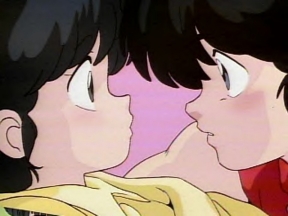 So, we've got this thing between Ranma and Akane.
Let's just talk about how they relate as boy(Ranma) and girl(Akane), first. Akane never says or thinks anything about
Ranma's curse turning her off. For the intents and purposes of their engagement, she seems to think of him like any other male.
Ranma and Akane grudgingly go along with their engagement, never actually get married in the course of the series. (The series ends with their fathers forcing a wedding, which gets crashed and ruined by all their foes and ex-suitors.)
Actually, they never really "hook up" with each other or anybody else. While unresolved sexual tension is a mainstay of any series (X-Files and Xena: Warrior Princess pop immediately to mind), the degree to which Akane and Ranma avoid romantic
entanglements is extraordinary. 98% of the time, they want nothing to do with each other.
However, their lack of sexual interest may have something to do with the fact that Ranma 1/2 is Japanese (and not hentai anime). Or rather, the lack of sexual interest I perceive may have something to do with the fact that Ranma 1/2 isn't American, and I am.
So, we've got this thing between Ranma and Akane.
Let's just talk about how they relate as boy(Ranma) and girl(Akane), first. Akane never says or thinks anything about
Ranma's curse turning her off. For the intents and purposes of their engagement, she seems to think of him like any other male.
Ranma and Akane grudgingly go along with their engagement, never actually get married in the course of the series. (The series ends with their fathers forcing a wedding, which gets crashed and ruined by all their foes and ex-suitors.)
Actually, they never really "hook up" with each other or anybody else. While unresolved sexual tension is a mainstay of any series (X-Files and Xena: Warrior Princess pop immediately to mind), the degree to which Akane and Ranma avoid romantic
entanglements is extraordinary. 98% of the time, they want nothing to do with each other.
However, their lack of sexual interest may have something to do with the fact that Ranma 1/2 is Japanese (and not hentai anime). Or rather, the lack of sexual interest I perceive may have something to do with the fact that Ranma 1/2 isn't American, and I am.
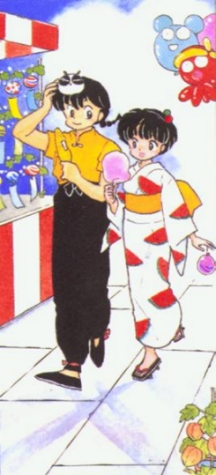 Annalee Newitz writes:
Annalee Newitz writes:
"In America, young men (and, increasingly, young women) are
encouraged by their popular youth culture to experience their romantic feelings
as overtly sexual. Romantic comedies in America are largely sex comedies, not
comedies about emotions and wishes. I think in many ways young American
men become fans of romantic comedy anime because they represent a form of
heterosexual masculinity which is not rooted in sexual prowess, but romantic
feelings. Anime offer to the post-sexual revolution generation romantic comedy
narratives which suggest that young men and women do not need to have sex in
order to experience love. Admittedly, the kind of love recommended by these
anime is often based on social values American feminism has done right to
condemn. But the Americans who consume them are also responding to -- and
perhaps attempting to escape -- the hypersexuality of their own media culture
by reimagining romance as a relationship which goes beyond the purely sexual."(end quote)
The absence of a physical side to Akane and Ranma's relationship could be read as a reflection of Japanese media culture values.
But couldn't it also be said that they are resisting a relationship constructed for the sake of obligatory heterosexual partnership?
The idea of a sex-switching character and a tomboy resisting their forced engagement and arranged marriage, the most heteronormative institution of all,
is too great a transgressive, queer concept to pass up.
"I'm just glad you're not a boy. . ."
Let's not forget, though. . . Akane was really happy to know Ranma when she thought Ranma was a girl.
Maybe a little too happy? Okay, I'm being all coy here, but seriously. . . the possibility that Akane likes girls, romantically,
is definitely there for the pondering. All signs seem to tell us that she doesn't like boys. Her family says that she and Ranma should
be married because Akane hates boys and Ranma is half girl.
 Ranma is the only boy that Akane doesn't beat senseless
(well, she only does it every once and a while), the only boy who stands any kind of chance with her romantically.
Maybe Ranma 1/2 is the story of a queer girl (Akane) trapped in a straight world, who lucks out and finds a queer fiancee
cleverly disguised as a straight boy.
Ranma is the only boy that Akane doesn't beat senseless
(well, she only does it every once and a while), the only boy who stands any kind of chance with her romantically.
Maybe Ranma 1/2 is the story of a queer girl (Akane) trapped in a straight world, who lucks out and finds a queer fiancee
cleverly disguised as a straight boy.
There is one memorable moment early in the series that hints at a possible lesbian attraction between Ranma and Akane.
Ranma, in girl form, rescues Akane from a deadly attack. Ranma carries Akane to a safe rooftop and they rest for a moment in each others arms.
Ranma snaps out of their intimate moment first, then they both freeze in wonderment and finally Akane scoots away. 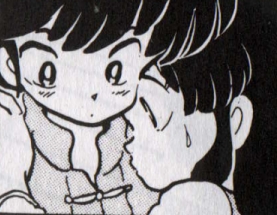 Akane seems to be the one actively censoring here, while Ranma looks to her in confusion.
If we read this scene as a moment of homosensuality for Akane (could it be called homosensuality for Ranma, always a boy inside?),
then it is also a decisive moment, in which she closets her feelings for female Ranma. Hereafter, either Akane, Ranma or both
protest public displays of affection when Ranma is in female form. When female Ranma is almost forced to kiss Akane as part of an outdoor contest, Akane
screams "but we're both girls!!" Ranma cries with equal urgency that he wasn't really going to do it.
It seems they can both handle some kind of partnership, and that partnership can be queer (as in not heteronormative,) but they can't deal with anything approaching homosexuality.
Akane seems to be the one actively censoring here, while Ranma looks to her in confusion.
If we read this scene as a moment of homosensuality for Akane (could it be called homosensuality for Ranma, always a boy inside?),
then it is also a decisive moment, in which she closets her feelings for female Ranma. Hereafter, either Akane, Ranma or both
protest public displays of affection when Ranma is in female form. When female Ranma is almost forced to kiss Akane as part of an outdoor contest, Akane
screams "but we're both girls!!" Ranma cries with equal urgency that he wasn't really going to do it.
It seems they can both handle some kind of partnership, and that partnership can be queer (as in not heteronormative,) but they can't deal with anything approaching homosexuality.
Ranma's nightmare
Ranma is most traumatized when boys profess their love to him. Of course, he's almost always in female form when this happens.
Ranma's first misunderstaning of this sort is with Kuno, the incredibly arrogant, utterly serious captain of the high school kendo (fencing) club. While Kuno despises
Ranma as a boy (for stealing Akane), the charms of the "pigtailed girl" prove irresistable. Kuno cannot comprehend that Ranma and the pigtailed girl are one in the same, even when Ranma
transforms in his arms. Ranma has a nightmare about Kuno that night, in which we get our first real glimpse of what might be going on inside our protagonist's head.
Click to view the nightmare.
"I'm a boy!" Ranma insists as he flees the amorous Kuno. Not "I'm straight!" or "I like girls!" Ranma takes heterosexuality for granted in his understanding of gender and sex.
Boys like girls, girls like boys. In this instance, there's no getting around the heteronormativity of the situation, Ranma's attitude and Takahashi's writing.
It had to happen sometime. . .Ranma's first kiss
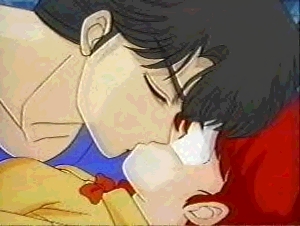 Ranma and Akane go ice skating. Ranma chooses to go as a girl, because he's embarrassed at his lack of skating skill.
He figures he'll look cuter and less ridiculous in falling on his butt in female form.
Unfortunately for Ranma, high school champion figure skater Mikado Sanzenin is on the rink
that day. Mikado has a thing about kissing, and a thing for damsels in distress. . . and there's Ranma,
looking like a helpless girl (as opposed to a helpless boy). . .
Ranma and Akane go ice skating. Ranma chooses to go as a girl, because he's embarrassed at his lack of skating skill.
He figures he'll look cuter and less ridiculous in falling on his butt in female form.
Unfortunately for Ranma, high school champion figure skater Mikado Sanzenin is on the rink
that day. Mikado has a thing about kissing, and a thing for damsels in distress. . . and there's Ranma,
looking like a helpless girl (as opposed to a helpless boy). . . 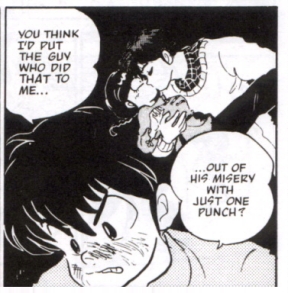 Mikado steals a kiss from a bewhildered Ranma, who turns into an utterly shattered Ranma.
(click for the full scene, manga version.) Ranma runs away sobbing, but vows revenge
and ends up trouncing Mikado and partner in a martial arts skating match with Akane (Ranma as boy partner) and
another male character, Ryoga (with Ranma as female partner).
Mikado steals a kiss from a bewhildered Ranma, who turns into an utterly shattered Ranma.
(click for the full scene, manga version.) Ranma runs away sobbing, but vows revenge
and ends up trouncing Mikado and partner in a martial arts skating match with Akane (Ranma as boy partner) and
another male character, Ryoga (with Ranma as female partner).
Two little things to point out -- (1) Before we judge Ranma's reaction to Mikado's kiss, take a look at Ranma's reaction to a similar situation (forced kissing!)
with Kodachi Kuno, the Black Rose. She paralyzes him with a special gas, and as she leans in and tries for a smooch Ranma's eyes bug, his face gets superdeformed and he freaks out almost as badly as with Mikado.
Kissing boys may upset Ranma, but it seems as thought kissing period upsets him almost as much. Which brings us to (2) After Ranma catches a lot of teasing for never having kissed anyone before Mikado, he and
Akane decide to try kissing. They can't bear to touch lips, however! After this, one has to reflect back on Akane's statement, "I guess he would feel like crying. . .after being kissed by a boy." Hmmm, perhaps it isn't a
sympathetic statement, so much as an empathetic one? (I'll never let go of the lesbian angle. . .)
A step-by-step guide: how to draw Female Boy
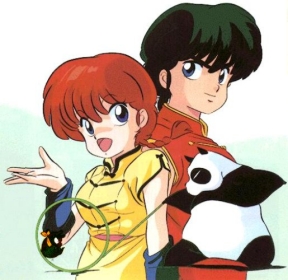 Rumiko Takahashi often draws Ranma as two seperate people posed together.
What to make of this? These double images of Ranma, his female "cursed" body extracted and abstracted, work against the queer notion of a female boy.
Rumiko Takahashi often draws Ranma as two seperate people posed together.
What to make of this? These double images of Ranma, his female "cursed" body extracted and abstracted, work against the queer notion of a female boy.
Within stories female Ranma always stays in character; that is, female Ranma always acts like a boy with a female body.
But cover images, calendar pictures, and many other non-story images of female Ranma show him as very much a her -- doing things Ranma himself wouldn't do on a bet.
Like. . . 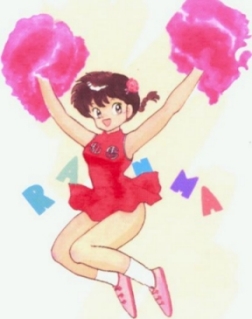 cheerleading with pom poms and a miniskirt, for example. I see two ways to read these images.
One, the way I suspect Rumiko Takahashi imagines them, is as a seperate, abstracted female Ranma. Not the boy we know, the
resolutely male Ranma who struggles to retain masculinity even when forced into the cutest, most femme of appearances.
This is a different Ranma, a fully female character who does not appear in the stories, but a momentary realization of the personality which might inhabit
that girl body, if sex determined gender determined identity. Wooh, kind of creepy, eh? The other reading I see (and the one I hope Takahashi imagines)
is that these seemingly out-of-character Ranmas are actually a queer exploration -- what Ranma could be if he weren't quite so straight.
cheerleading with pom poms and a miniskirt, for example. I see two ways to read these images.
One, the way I suspect Rumiko Takahashi imagines them, is as a seperate, abstracted female Ranma. Not the boy we know, the
resolutely male Ranma who struggles to retain masculinity even when forced into the cutest, most femme of appearances.
This is a different Ranma, a fully female character who does not appear in the stories, but a momentary realization of the personality which might inhabit
that girl body, if sex determined gender determined identity. Wooh, kind of creepy, eh? The other reading I see (and the one I hope Takahashi imagines)
is that these seemingly out-of-character Ranmas are actually a queer exploration -- what Ranma could be if he weren't quite so straight.
Imagine that it is our own Ranma boy in these female-form pictures (not some new, abstracted, girl-identified Ranma), and they take on a hilariously entertaining queerness.
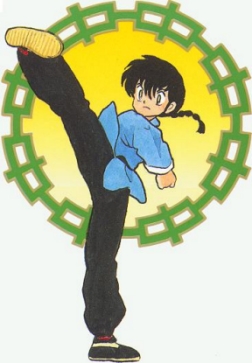 In the case of the cheerleading picture, even a camp quality.
In the case of the cheerleading picture, even a camp quality.
There is nothing overtly queer about Ranma himself, alone, when he has a male body. We have seen how he identifies as "a boy!!" and therefore heterosexual. But it is that
very identification, that fundamental and firm identification as a boy, that makes Ranma so very queer with a female body. When he transforms, Ranma totally fucks up the sex-gender connection.
We know his sexual and romantic feelings towards boys do not change with his body,
but Ranma's sex confusion in turn confuses his feelings towards girls. There are those moments with Akane, where he looks lost but not panicked, innocently muddled, with none of the shame or horror of his encounters with Kuno or Mikado.
And yet, he hesitates. Ranma is still trying to figure out the implications of his two bodies on his sexual identity. . . (and he has very little chance of coming to any conclusions, since his creator fails to do more than flirt with the discussion herself).
How Ranma 1/2 and Ranma are queer
Ranma's female body and his transformative power are called a curse.
Almost never does he take pleasure or pride in his female form.
It just wouldn't mesh with his identity as a boy. But in the episode titled "Dharma Chameleon," a transgender character named Tsubasa shows up
and challenges Ranma to a cute contest, calling Ranma "butt ugly." Ranma is enraged, and is compelled to don a playboy bunny suit, fishnets and heels to win the support of the local teenage boys.
Two characters, both born male, competing to see who can achieve the highest level of
feminine cuteness? At last, an unarguably queer moment in a Ranma 1/2 story!!
In the picture of Ranma measuring his breasts below, he seems to take pride and pleasure
in his female body. There is a resonance in this vaguely autoerotic image which rings in the double Ranma images shown earlier.
Could these Ranma & Ranma portraits be interpreted in a third, more transgressive way, with Ranma encompassing a couple all by himself?
This might be the most radical queering of Ranma yet.
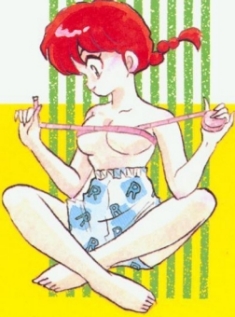
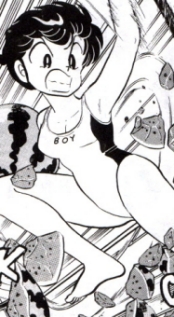

In conclusion: Ranma 1/2 works as a queer cultural production, in the sense that it puts forth queer notions of gender/sex, body/identity connections through the character
of a boy with both male and female bodies. In both its manga and anime incarnations, the series also contains moments of homoeroticism and unconvenetional sexuality and desire.
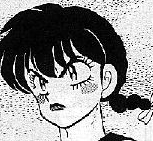 Hmmm. . . since that's kind of a sober conclusion, here's a fabulously queer manga image of
the men of Ranma 1/2 in drag!
There, that's much more appropriate.
Hmmm. . . since that's kind of a sober conclusion, here's a fabulously queer manga image of
the men of Ranma 1/2 in drag!
There, that's much more appropriate.


 If he were a real person, Ranma Saotome would probably be horrified at being considered queer.
No matter that he identifies as male and has a female body some of the time, Ranma tries very hard
to be as straight as possible.
If he were a real person, Ranma Saotome would probably be horrified at being considered queer.
No matter that he identifies as male and has a female body some of the time, Ranma tries very hard
to be as straight as possible.
 So, we've got this thing between Ranma and Akane.
Let's just talk about how they relate as boy(Ranma) and girl(Akane), first. Akane never says or thinks anything about
Ranma's curse turning her off. For the intents and purposes of their engagement, she seems to think of him like any other male.
Ranma and Akane grudgingly go along with their engagement, never actually get married in the course of the series. (The series ends with their fathers forcing a wedding, which gets crashed and ruined by all their foes and ex-suitors.)
Actually, they never really "hook up" with each other or anybody else. While unresolved sexual tension is a mainstay of any series (X-Files and Xena: Warrior Princess pop immediately to mind), the degree to which Akane and Ranma avoid romantic
entanglements is extraordinary. 98% of the time, they want nothing to do with each other.
However, their lack of sexual interest may have something to do with the fact that Ranma 1/2 is Japanese (and not hentai anime). Or rather, the lack of sexual interest I perceive may have something to do with the fact that Ranma 1/2 isn't American, and I am.
So, we've got this thing between Ranma and Akane.
Let's just talk about how they relate as boy(Ranma) and girl(Akane), first. Akane never says or thinks anything about
Ranma's curse turning her off. For the intents and purposes of their engagement, she seems to think of him like any other male.
Ranma and Akane grudgingly go along with their engagement, never actually get married in the course of the series. (The series ends with their fathers forcing a wedding, which gets crashed and ruined by all their foes and ex-suitors.)
Actually, they never really "hook up" with each other or anybody else. While unresolved sexual tension is a mainstay of any series (X-Files and Xena: Warrior Princess pop immediately to mind), the degree to which Akane and Ranma avoid romantic
entanglements is extraordinary. 98% of the time, they want nothing to do with each other.
However, their lack of sexual interest may have something to do with the fact that Ranma 1/2 is Japanese (and not hentai anime). Or rather, the lack of sexual interest I perceive may have something to do with the fact that Ranma 1/2 isn't American, and I am.
 Annalee Newitz writes:
Annalee Newitz writes:
 Ranma is the only boy that Akane doesn't beat senseless
(well, she only does it every once and a while), the only boy who stands any kind of chance with her romantically.
Maybe Ranma 1/2 is the story of a queer girl (Akane) trapped in a straight world, who lucks out and finds a queer fiancee
cleverly disguised as a straight boy.
Ranma is the only boy that Akane doesn't beat senseless
(well, she only does it every once and a while), the only boy who stands any kind of chance with her romantically.
Maybe Ranma 1/2 is the story of a queer girl (Akane) trapped in a straight world, who lucks out and finds a queer fiancee
cleverly disguised as a straight boy.
 Akane seems to be the one actively censoring here, while Ranma looks to her in confusion.
If we read this scene as a moment of homosensuality for Akane (could it be called homosensuality for Ranma, always a boy inside?),
then it is also a decisive moment, in which she closets her feelings for female Ranma. Hereafter, either Akane, Ranma or both
protest public displays of affection when Ranma is in female form. When female Ranma is almost forced to kiss Akane as part of an outdoor contest, Akane
screams "but we're both girls!!" Ranma cries with equal urgency that he wasn't really going to do it.
It seems they can both handle some kind of partnership, and that partnership can be queer (as in not heteronormative,) but they can't deal with anything approaching homosexuality.
Akane seems to be the one actively censoring here, while Ranma looks to her in confusion.
If we read this scene as a moment of homosensuality for Akane (could it be called homosensuality for Ranma, always a boy inside?),
then it is also a decisive moment, in which she closets her feelings for female Ranma. Hereafter, either Akane, Ranma or both
protest public displays of affection when Ranma is in female form. When female Ranma is almost forced to kiss Akane as part of an outdoor contest, Akane
screams "but we're both girls!!" Ranma cries with equal urgency that he wasn't really going to do it.
It seems they can both handle some kind of partnership, and that partnership can be queer (as in not heteronormative,) but they can't deal with anything approaching homosexuality.
 Ranma and Akane go ice skating. Ranma chooses to go as a girl, because he's embarrassed at his lack of skating skill.
He figures he'll look cuter and less ridiculous in falling on his butt in female form.
Unfortunately for Ranma, high school champion figure skater Mikado Sanzenin is on the rink
that day. Mikado has a thing about kissing, and a thing for damsels in distress. . . and there's Ranma,
looking like a helpless girl (as opposed to a helpless boy). . .
Ranma and Akane go ice skating. Ranma chooses to go as a girl, because he's embarrassed at his lack of skating skill.
He figures he'll look cuter and less ridiculous in falling on his butt in female form.
Unfortunately for Ranma, high school champion figure skater Mikado Sanzenin is on the rink
that day. Mikado has a thing about kissing, and a thing for damsels in distress. . . and there's Ranma,
looking like a helpless girl (as opposed to a helpless boy). . .  Mikado steals a kiss from a bewhildered Ranma, who turns into an utterly shattered Ranma.
(click for the full scene, manga version.) Ranma runs away sobbing, but vows revenge
and ends up trouncing Mikado and partner in a martial arts skating match with Akane (Ranma as boy partner) and
another male character, Ryoga (with Ranma as female partner).
Mikado steals a kiss from a bewhildered Ranma, who turns into an utterly shattered Ranma.
(click for the full scene, manga version.) Ranma runs away sobbing, but vows revenge
and ends up trouncing Mikado and partner in a martial arts skating match with Akane (Ranma as boy partner) and
another male character, Ryoga (with Ranma as female partner). Rumiko Takahashi often draws Ranma as two seperate people posed together.
What to make of this? These double images of Ranma, his female "cursed" body extracted and abstracted, work against the queer notion of a female boy.
Rumiko Takahashi often draws Ranma as two seperate people posed together.
What to make of this? These double images of Ranma, his female "cursed" body extracted and abstracted, work against the queer notion of a female boy.
 cheerleading with pom poms and a miniskirt, for example. I see two ways to read these images.
One, the way I suspect Rumiko Takahashi imagines them, is as a seperate, abstracted female Ranma. Not the boy we know, the
resolutely male Ranma who struggles to retain masculinity even when forced into the cutest, most femme of appearances.
This is a different Ranma, a fully female character who does not appear in the stories, but a momentary realization of the personality which might inhabit
that girl body, if sex determined gender determined identity. Wooh, kind of creepy, eh? The other reading I see (and the one I hope Takahashi imagines)
is that these seemingly out-of-character Ranmas are actually a queer exploration -- what Ranma could be if he weren't quite so straight.
cheerleading with pom poms and a miniskirt, for example. I see two ways to read these images.
One, the way I suspect Rumiko Takahashi imagines them, is as a seperate, abstracted female Ranma. Not the boy we know, the
resolutely male Ranma who struggles to retain masculinity even when forced into the cutest, most femme of appearances.
This is a different Ranma, a fully female character who does not appear in the stories, but a momentary realization of the personality which might inhabit
that girl body, if sex determined gender determined identity. Wooh, kind of creepy, eh? The other reading I see (and the one I hope Takahashi imagines)
is that these seemingly out-of-character Ranmas are actually a queer exploration -- what Ranma could be if he weren't quite so straight.
 In the case of the cheerleading picture, even a camp quality.
In the case of the cheerleading picture, even a camp quality.



 Hmmm. . . since that's kind of a sober conclusion, here's a fabulously queer manga image of
the men of Ranma 1/2 in drag!
There, that's much more appropriate.
Hmmm. . . since that's kind of a sober conclusion, here's a fabulously queer manga image of
the men of Ranma 1/2 in drag!
There, that's much more appropriate.